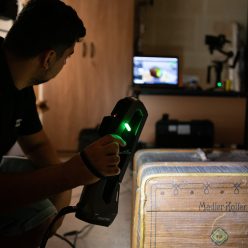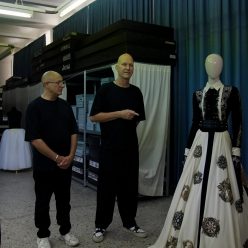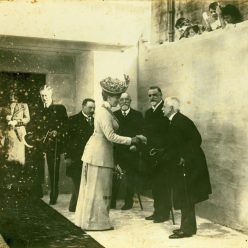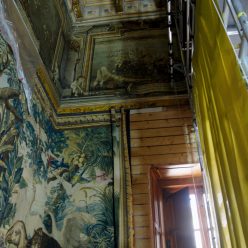Stqarrija bil-Malti Agħfas Hawn / Press Release in Maltese Click Here
A large bowl excavated at the Tarxien Prehistoric Complex by Temi Zammit has been successfully restored and relocated to the original place where it was found more than a century ago, thanks to a joint effort by Heritage Malta curators and the agency’s conservation and digitisation teams.
In August 1915, during the excavation of the Tarxien Prehistoric Complex under Zammit’s direction, the remains of a large bowl carved out of stone were discovered next to one of the doorways inside the structure that was being uncovered. The bowl was completely shattered and missing some fragments. It was nonetheless impressive, both in size as well as for the fact that rather than being made of clay, it had been carved from stone.
The pieces of the vessel were collected and put together, with photos taken in 1916 showing it in a chamber close to where it had been found. Zammit left no details as to why it was placed in this chamber, but this was likely due to the fear that once restored, the bowl might not fit in the location where it had been found. It was probably safer to restore it in an area that provided access to it all around and ensured that once the pieces were joined together there would be enough space to accommodate it.

In 1917, the missing pieces of the bowl were reproduced and attached to the original ones to make the vessel look whole.
Over the years, the bowl suffered occasional damage which was repaired from time to time. The ensuing results were layers of modern materials, such as various glues and cement, adhering to the vessel, as well as a bowl that was not quite in its original shape.
At the start of 2023, curators of the site, seeing the poor state of the vessel, launched a project for its restoration, while also posing the question of whether it could actually be returned to the original location where it had been discovered in 1915. To this end, Heritage Malta’s Conservation Department and Digitisation Unit of Heritage Malta also joined the project.
The Conservation Department’s intervention included thorough documentation, the dismantling of the pot into single pieces, cleaning, and finally reassembling. The conservators also attentively recorded the methodology of the undocumented past interventions. Samples of the cement mortar detached from the edges of the various pieces were collected and are currently being analysed by Heritage Malta scientists, in an attempt to establish whether the mortar mixtures in these samples are different or the same, thus establishing whether they were done in one go or in different periods of time.

The Digitisation Unit team was tasked with laser scanning the bowl’s location and determining if the vessel could be returned to its original place. The team also provided resources which proved to be immensely valuable during the dismantling carried out by the conservators. Post-disassembly, the digitisation team meticulously laser scanned each of the approximate 55 components, referencing the assigned numbers. These digitised parts facilitated a virtual reassembly.
Once assembled digitally, it was determined that the artefact could in fact be returned to its original position. One of the biggest advantages of this technique was that the delicate reconstruction process could be done virtually, without experimenting with the original artefact pieces. The digital twin of the bowl before restoration and after reassembly provides detailed documentation references which would not have been possible using traditional 2D photography. This is a time-consuming and very meticulous process but one which guarantees the highest precision possible. This was the first time such a technique was used at Heritage Malta.
Armed with the digitisation team’s documentation and visuals, conservators executed the project’s culmination. The project took six months to complete, including the conservation-restoration of the location where the pot was assembled. This monumental endeavor highlighted the seamless collaboration between curators, conservators and the digitisation team, resulting in the successful relocation of the bowl after more than a century in a different location.

Latest News

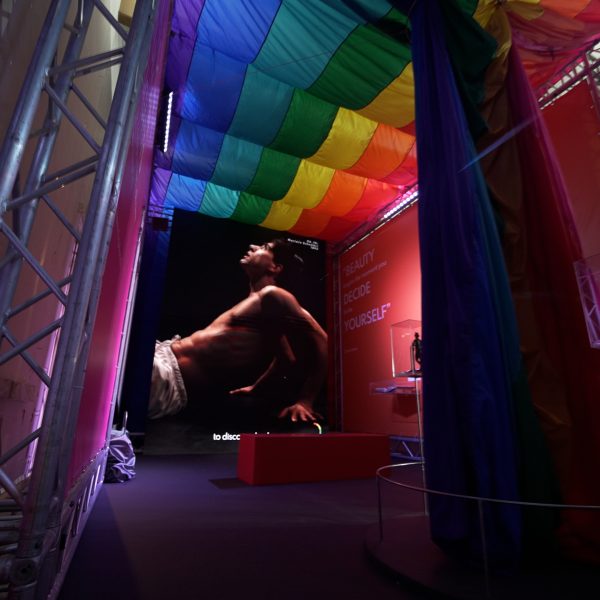
Up Next
Press Releases | 7th September 2023
